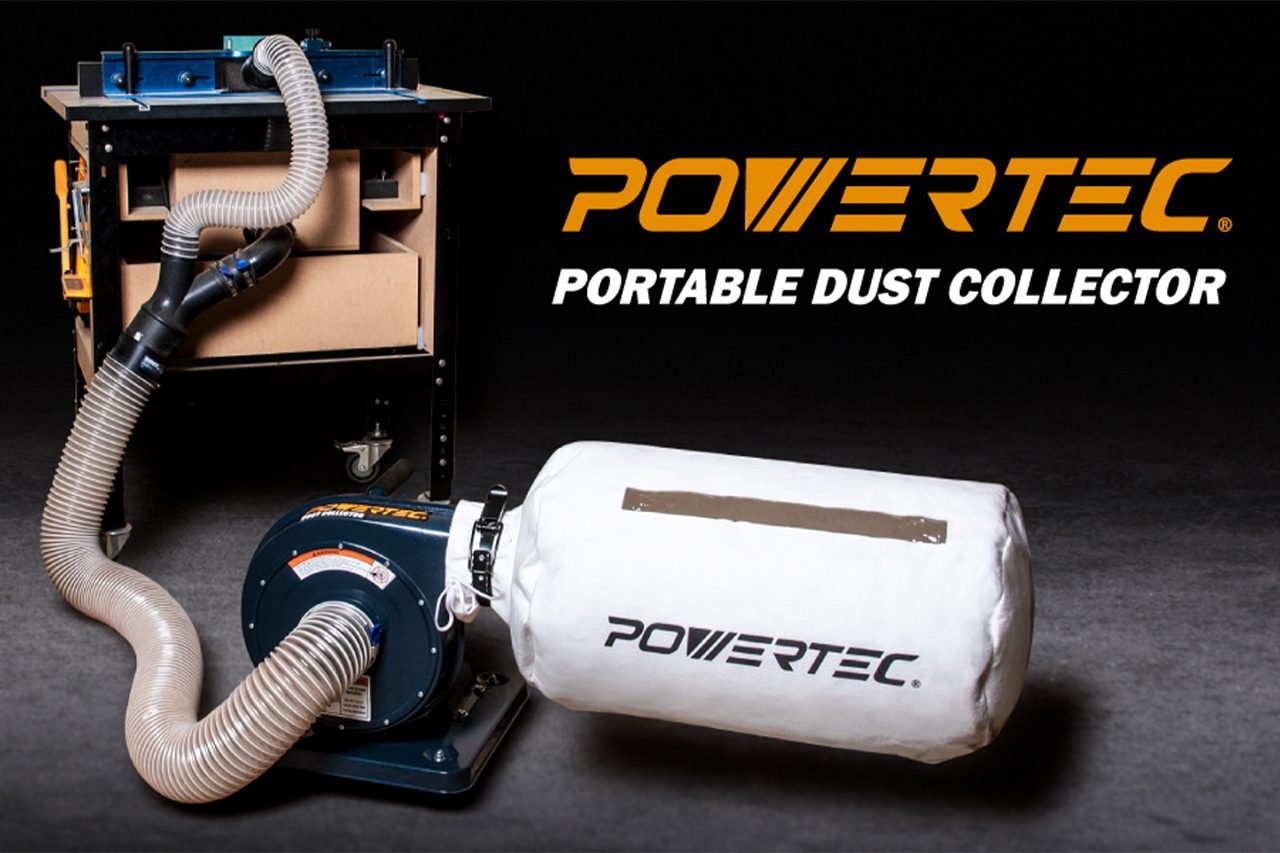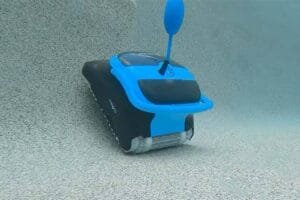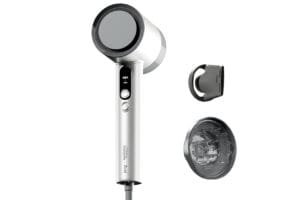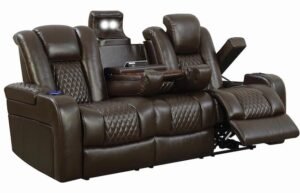If you’ve been putting off real dust collection because you don’t have the space (or the budget) for a full-size cyclone, POWERTEC’s DC5372 is the kind of tool that gets you off the fence. It’s a compact, wheeled, single-stage 1-horsepower dust collector rated at 560 CFM and equipped with a reusable 1-micron filter bag—plus a smart “Vortex Base” that streamlines airflow so more chips and fine dust actually make it into the bag. In a one-car garage or small pro shop, that combination checks a lot of boxes most benchtop collectors miss.
What this machine does is simple but important: it moves a lot of air (for its size) from a 4-inch hose, right at the source, and traps the fines that make your lungs unhappy. The included bag now has a viewing window and a bottom zipper, so you can see when it’s time to empty and dump it out without wrestling the band clamp. The base rides on casters, the handle is sturdy, and the dual-voltage induction motor (120V/240V) avoids the shrill “shop-vac scream” that pushes you out of the room.
POWERTEC has been quietly earning a following among woodworkers for practical dust-collection gear and OEM accessories. This unit fits their DNA: straightforward, durable, and focused on the fundamentals—airflow, filtration, and ease of use—without gimmicks. It’s not a silver bullet for whole-shop ductwork, but for point-of-use collection at a table saw, planer, jointer, or router table, it’s a compelling, space-savvy answer.
Is POWERTEC DC5372 for you?
The big problem this solves is getting a real 4-inch dust-collection hookup into a small or shared workspace—so your saw doesn’t fog the room and your planer doesn’t bury the floor in curly shavings. If you’ve been doing the “shop-vac plus dust separator” routine and finding it underwhelming at the table saw or thickness planer, the DC5372 gives you that next-level airflow without committing to a ceiling-height tower or hard ducting.
It’s ideal for hobbyist shops, furniture makers working piece-by-piece, DIYers, and pros who need a portable unit that can roll tool-to-tool. If you typically run one machine at a time, keep hose runs short, and want filtration down to 1 micron baked in, this is squarely in your lane.
It’s not for you if you need to pull from multiple drops simultaneously, run long 4-inch duct runs with elbows, or support large-throat machinery that really wants 6-inch ports. In those cases, step up to higher horsepower or a cyclone with larger inlets and a canister filter.
In the price landscape, this is a budget-to-mid option that prioritizes essentials (induction motor, 1-micron bag, mobility) over extras like remote controls or cartridge canisters. It is beginner-friendly—assembly is straightforward, the controls are obvious, and maintenance is simple as long as you stick to a short checklist (see Maintenance below).
What We Like About the POWERTEC DC5372
The first impression is how unfussy it is. The induction motor starts smoothly, settles into a lower-pitch hum than a shop vac, and just goes about its business. With a 4-inch hose, the 560 CFM rating translates to credible real-world pulling power at the tool. On planers and jointers that spew bulky chips, the DC5372 keeps up if you keep the hose run efficient and open.
POWERTEC’s Vortex Base isn’t marketing lip service. The smoother airflow path reduces the chaotic swirl you sometimes see in single-stage collectors; chips and fines make a decisive turn into the bag instead of ping-ponging around the housing. In use, that shows up as less dust burping out of open seams and fewer “snowstorms” when the bag is half full.
In small shops, the mobility matters. The compact footprint and casters make it easy to slide next to a tool, run your cut or milling pass, and roll it out of the way. That handle on the housing is not an afterthought—it’s placed where you naturally grab it, which gives you one-hand control as you navigate cords and hoses.
The 1-micron bag with window and bottom zipper solves two classic pain points. You can actually see when the bag needs attention, and you can empty it without detaching the band clamp every single time. Filtration at 1 micron is a meaningful step up from the “chips only” bags common on bargain units; it helps keep your air clearer, especially if you’re cutting MDF or sanding solid wood.
Finally, the dual-voltage design (12A at 120V / 6A at 240V) gives you flexibility. Most users will simply plug into a standard 120V circuit; if you’re wiring for 240V anyway and want a bit more headroom on your breaker panel, it’s there.
What We Don’t Like About the POWERTEC DC5372
No single-stage, 1-HP collector is a miracle worker. The 560 CFM rating is healthy for a portable, but it’s still a one-machine, short-run solution. If you add too many elbows, run 15–20 feet of hose, or try to pull from two tools with a Y-split, airflow assurance goes out the window.
The 4-inch inlet grate is a mixed blessing. It protects the impeller from larger debris (good), but it can collect chips and stringy shavings and slowly choke the port if you never check it (bad). The manual guidance is clear: pull the hose periodically and clear any buildup around the grate.
Filtration is bag-based, not a canister. The 1-micron rating is solid, but you won’t get the surface area or pulse-clean convenience of a pleated cartridge. If you’re chasing near-HEPA performance at the machine, you’ll want to step up to a canister system or add ambient filtration to your room.
There’s no remote by default, no auto-start, and no hose included. Assembly is easy and the hardware pack is complete, but this is a functional, no-frills collector. Also, while the induction motor is calmer than a wet/dry vac, it still makes workshop-level noise—you’ll want hearing protection during longer sessions.
Pros & Cons
| Pros | Cons |
|---|---|
| Compact, portable 1-HP collector that actually moves air (560 CFM) | Not designed for long duct runs or multiple tools at once |
| 1-micron reusable bag with view window and bottom zipper | Bag filter, not a pleated canister |
| Vortex Base reduces turbulence; better fine-dust capture vs basic designs | 4″ inlet grate can clog; requires periodic checks |
| Dual-voltage induction motor (120V/240V) | No remote/auto-start; hose not included |
| Easy to roll and park next to the tool; small footprint | Still loud enough to warrant hearing protection |
| Straightforward setup, clear maintenance routine | Single 4″ inlet only |
What’s Included?
- POWERTEC DC5372 portable dust collector (1-HP, 560 CFM) with wheeled base
- 1-micron reusable dust filter bag with window and bottom zipper
- Hardware for assembly and bag mounting (band clamp, fasteners)
- Owner’s documentation / safety instructions
For a unit at this level, this is a sensible bundle. You get everything to run the machine immediately except the 4-inch hose and fittings, which most users will size to their tool anyway. I’d rather POWERTEC keep the price lean than toss in a short, generic hose I won’t use. The only addition I wish came in the box is a simple remote or a short pigtail with a paddle switch that could be magnet-mounted—nice to have, not essential.
Technical Specifications
| Spec | Detail |
|---|---|
| Motor | 1 HP induction, 120V/240V (60 Hz, 1-phase) |
| Current Draw | 12A at 120V / 6A at 240V |
| Motor Speed | 3450 RPM |
| Airflow Capacity | 560 CFM (4-inch inlet) |
| Inlet Size | 4 inches (with protective grate) |
| Filtration | 1-micron reusable bag; viewing window + bottom zipper |
| Mobility | Wheeled base with handle |
| Bag Maintenance | Unzip bottom to empty; remove/clean as needed |
| Included | Collector, hardware, 1-micron bag |
Note: As with all single-stage collectors, performance depends on hose length, fittings, and the tool’s port design. Keep runs short and smooth for best results.
Features
- Portable, compact footprint—rolls easily from tool to tool on casters
- Vortex Base—streamlined internal path reduces turbulence and boosts effective collection (POWERTEC cites up to ~10% improved efficiency over comparative designs)
- Dual-voltage induction motor—run on 120V or 240V, smooth start, lower pitch than a shop-vac motor
- 560 CFM airflow at a 4-inch inlet—appropriate for table saws, planers, jointers, router tables, drum sanders with short runs
- 1-Micron reusable bag—captures fine dust, includes window to see fill level and a bottom zipper for easy emptying
- Protective inlet grate—prevents large debris from contacting the impeller (requires periodic cleaning)
- Tool-agnostic hookup—attach a 4-inch dust-collection hose directly to your machine’s port
- Simple controls & assembly—get up and running quickly without specialty wiring (120V compatible out of the box)
Opinion on the feature set: This is the right mix for small-shop woodworking. POWERTEC spent its money where it matters: an induction motor you can live with, real 1-micron filtration, and small quality-of-life features that cut friction—like the bag window and zipper. The Vortex Base won’t turn physics upside down, but paired with short, clean hose runs it does help the DC5372 punch above what many expect from a 1-HP portable.
Real-World Setup & Use
Assembly is straightforward. Bolt the base, mount the housing, fit the bag with the band clamp, and you’re basically done. Plan your hose path before you push the switch—every elbow, rib, and crimp steals airflow. A quality 4-inch flex hose with smooth interior walls and gentle curves makes a bigger difference than most folks expect.
For a table saw, the collector excels when you:
- Seal obvious cabinet leaks with foam or tape, and
- Use a short, direct 4-inch run to the saw base.
If you add an overarm guard later, treat it as a separate drop; a Y-split off one 4-inch line is rarely satisfying with 1 HP.
On a thickness planer or jointer, the DC5372 shines. Chips are bulky but cooperative; keep the hose under ~10 feet and avoid tight turns. If your planer has a narrow port adapter, upgrade it to a full 4-inch outlet—bottlenecks are the fastest way to turn any collector into a chip fountain.
Router tables and band saws benefit as well. On a band saw, cover the lower wheel shroud opening so more air is forced across the cut line. On a router table, capture at the fence and cabinet separately if possible, but run one at a time with the DC5372.
Performance Notes
- Airflow feel: With a clean bag and short hose, the pull at the end of a 4-inch line is convincing. It’s not “pull your glove off” strong like a big cyclone on 6-inch duct, but it’s clearly a level above shop-vac territory.
- Fine dust behavior: The 1-micron bag captures fines far better than typical 5-micron or “chip-only” bags; your shop light won’t reveal the same glittering haze after cuts. Supplement with an ambient air cleaner if you sand a lot.
- Sustained use: Induction motors handle long sessions gracefully. Empty the bag before it bulges; a choked bag is the fastest way to tank performance.
- Noise: Expect workshop-normal noise. It’s a lower tone than a high-RPM universal motor, which makes it less grating over time—but wear hearing protection.
Mobility & Small-Shop Workflow
A portable collector lives or dies on friction. If it’s a pain to roll and hook up, you’ll skip it “just for this cut.” POWERTEC did the little things well: the handle is right where you want it; the casters don’t stick on sawdust; the base is stable enough that coiling a hose on top won’t topple it. Keep the collector parked close to the tool and wheel it with the hose still attached—less bending, more building.
For shared garages, the footprint is easy to tuck into a corner. If you park the collector against a wall, spin the housing so the 4-inch outlet points toward your most-used machine; fewer turns equal more CFM.
Maintenance & Safety
- Bag care: Shake or tap the bag gently when you empty it, and unzip the bottom zipper to dump directly into a trash bag or bin. Avoid overfilling; filtration drops as the bag loads up.
- Inlet grate: Every few sessions—especially after planing resinous woods—pull the hose and inspect the grate. Clear stringy shavings that wrap the bars; they’re sneaky performance killers.
- Seal checks: Dust collection is part airflow, part sealing. Retighten the bag band clamp occasionally and inspect for leaks around the housing.
- Electrical: On 120V, a dedicated 15A circuit is ideal. Don’t daisy-chain through a flimsy power strip. If you wire for 240V, follow local code and manufacturer guidance.
- PPE: Even with 1-micron capture, wear a mask when sanding or cutting sheet goods and run an ambient filter if you have one.
Comparisons & Buying Context
POWERTEC’s lineup at this horsepower spans a few form factors:
- DC5372 (this model): Portable, wheeled base with 1-micron bag. The most flexible for small shops that rearrange often.
- Wall-mounted variant: Same horsepower/filtration but hangs on the wall; a tidy solution if you want a fixed station and can live without wheels.
- Mobile-base tower style: Classic “bag tower” profile on a mobile base. It can be easier to park alongside a tool, but it occupies a taller volume.
Versus a shop-vac + separator, the DC5372 wins handily at tool collection through a 4-inch port—especially for planers/jointers and cabinet saws. Versus a 2-HP canister cyclone, the DC5372 is quieter, cheaper, and smaller, but obviously doesn’t match airflow or multi-drop capability. For many small shops, the strategic move is DC5372 now, cycle to a cyclone when space and workflow demand it, and keep the DC5372 as a secondary collector for sanding stations or jobsite work.
Tips for Getting the Best Results
- Keep it short and smooth. Use the shortest practical 4-inch hose with gentle curves.
- One machine at a time. Don’t split the line; you’ll halve your CFM and double your frustration.
- Open the port. If a tool ships with a 2-1/2″ adapter, upgrade to a full 4-inch hood/port.
- Empty early. Use the bag’s window as a cue; empty when it’s 2/3 full to preserve airflow.
- Check the grate. Make it a habit to clear the inlet bars, especially after long planing sessions.
- Leak patrol. Tape, foam, and magnetic covers turn marginal capture into acceptable capture.
- Add an ambient filter. Even with 1-micron capture, room air cleaners polish off the fines.
- Consider a remote switch. An aftermarket remote saves steps in small shops.
Who Will Love It (and Who Won’t)
You’ll love it if you’re a furniture hobbyist, weekend cabinet builder, or trim carpenter using stationary tools one at a time. If your shop is a shared garage bay and you need the collector to roll in and out, this is the form factor that keeps you honest about actually using dust collection every time.
You won’t love it if your workflow demands simultaneous collection from two ports, or if your layout requires long fixed duct runs with multiple elbows. In that world, higher horsepower and larger inlets are your friend.
Frequently Asked “Will it…?” Questions
Will it handle a 13″ lunchbox planer?
Yes—very well with a direct 4-inch hookup and a short hose. Empty the bag before it’s stuffed; planers produce massive volume fast.
Can I run a 2-1/2″ hose with an adapter?
You can, but you’ll choke the system. Stick to 4-inch whenever possible for meaningful airflow.
How often do I need to clean the bag?
Use the window to gauge fill level. Unzip the bottom and dump before it’s packed tight. If you notice performance dropping sooner than expected, check the inlet grate for chips.
Can I use blast gates and a small manifold?
You can, but open one gate at a time. Treat this as a portable collector that parks at the working tool.
Is 240V worth it?
The motor draws half the current at 240V, which can help on panels with limited 120V headroom. Performance is fundamentally the same—choose the voltage that simplifies your wiring.
The Bottom Line
The POWERTEC DC5372 is the practical answer for small shops that want real 4-inch dust collection without the cost or footprint of a cyclone. You get honest airflow, 1-micron filtration that matters, and a mobility package that nudges you to use it every time you turn on a tool. Respect its limits—short runs, one machine, regular bag/grate checks—and it rewards you with a far cleaner, healthier workspace.
| Preview | Product | Price | |
|---|---|---|---|
|
|
POWERTEC 1 HP, 560 CFM Portable Dust Collector with 1 Micron Dust Collector Bags, Dust Collectors… |
$299.99
$269.99 |
View on Amazon |
Final Breakdown
9.2 / 10
POWERTEC’s portable 1-HP collector does the fundamentals right: stable airflow, credible fine-dust capture, and a form factor that makes dust collection a default behavior rather than a chore. The Vortex Base is a thoughtful refinement, the bag window/zipper combo is the kind of small upgrade that saves time every week, and the dual-voltage induction motor is a reassuring long-term choice. It’s not a multi-drop solution and it won’t defy the physics of long duct runs, but that’s not what it tries to be.
If you’re currently wrestling a shop-vac and dreaming of cleaner cuts, the DC5372 is a worthy step up. I recommend it to hobbyists and small pro shops that work one machine at a time and want a reliable, no-drama collector they’ll actually use.






